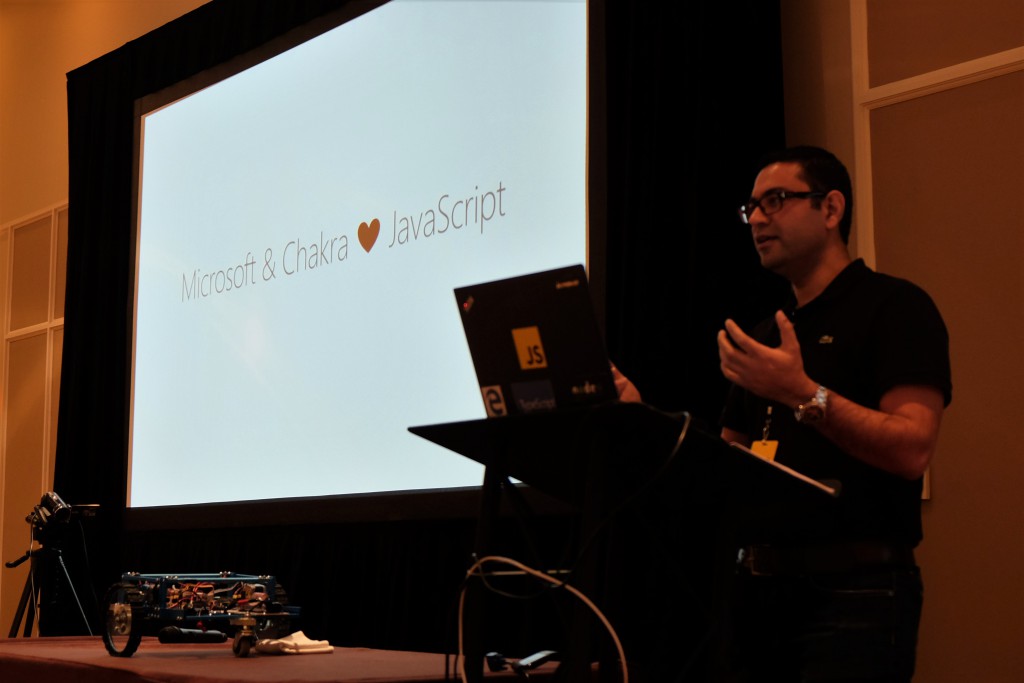Node.js
See the following -
5 DIY Hardware Platforms for Physiological Computing
 Physiological computing focuses on the use of biosignals for the development of interactive software and hardware systems capable of sensing, processing, reacting, and interfacing the digital and analog worlds. However, biosignals have specific requirements for which typical physical computing platforms are not particularly tuned. Until recently, many projects ended up hindered by high costs and limited access to suitable hardware materials. That scenario is different today, partially thanks to the following 5 DIY hardware platforms...
Physiological computing focuses on the use of biosignals for the development of interactive software and hardware systems capable of sensing, processing, reacting, and interfacing the digital and analog worlds. However, biosignals have specific requirements for which typical physical computing platforms are not particularly tuned. Until recently, many projects ended up hindered by high costs and limited access to suitable hardware materials. That scenario is different today, partially thanks to the following 5 DIY hardware platforms...
- Login to post comments
5 open source dashboard tools for visualizing data
 To start with a confession, I like dashboards. A lot. I've always been fascinated by finding new and interesting ways to bring meaning to data with interactive visualization tools. While I'm definitely a geek for numbers, the human mind is simply much better at interpreting trends visually than it is just picking them out a spreadsheet. And even when your main interest in a dataset is the raw numbers themselves, a dashboard can help to bring meaning by highlighting which values matter most, and what the context of those numbers is...
To start with a confession, I like dashboards. A lot. I've always been fascinated by finding new and interesting ways to bring meaning to data with interactive visualization tools. While I'm definitely a geek for numbers, the human mind is simply much better at interpreting trends visually than it is just picking them out a spreadsheet. And even when your main interest in a dataset is the raw numbers themselves, a dashboard can help to bring meaning by highlighting which values matter most, and what the context of those numbers is...
- Login to post comments
Amida Releases Enhanced Blue Button Software Component
Amida is pleased to announce the second release of its Data Reconciliation Engine (DRE). The DRE is a Blue Button-branded software component that supports the aims of the Blue Button Initiative, a nationwide public-private effort that enables patients and consumers to gain easy access to their own health information...
- Login to post comments
Amida Releases New Blue Button Software Component
Amida is pleased to announce the release of its first product, a Blue Button branded software component that supports the aims of the Blue Button Initiative, a nationwide public-private effort to enable patients and consumers to gain easy access to their own health information. Amida's Data Reconciliation Engine (DRE) is the first production-ready, format-agnostic open source health record interface in the health IT market...
- Login to post comments
Better Tech Is Here for Healthcare
 Better technology is out there serving other industries … and it can be applied in healthcare. Technology should ease administrative loads and put clinicians back in front of patients! I’ve talked about some of this previously and how we keep clinicians involved in our design process. When it came to building an entirely new EHR, the driving force behind our team researching and adopting new technologies was to imagine a clean slate...
Better technology is out there serving other industries … and it can be applied in healthcare. Technology should ease administrative loads and put clinicians back in front of patients! I’ve talked about some of this previously and how we keep clinicians involved in our design process. When it came to building an entirely new EHR, the driving force behind our team researching and adopting new technologies was to imagine a clean slate...
- Login to post comments
Chromecast: Understanding its Potential beyond Video Streaming
Google launched the $35 Chromecast into the US market in July 2013 and it became available in the UK in March 2014. It’s primarily marketed as a device for streaming video to your TV, and, as such, is usually compared with the Roku streamer, Apple TV and the new Amazon Fire TV. Once you look under the covers, you discover that such comparisons are misleading: unlike the other devices, the Chromecast is actually much more than just a streaming device for TV.
- Login to post comments
EWD.js and VistA: Now With No Barriers to Entry
Over the past few weeks I’ve been busy. Before explaining what I’ve been busy doing, I’ll start by stating my sincere thanks to Christopher Edwards (KRM Associates and Certification Manager at OSEHRA) for enhancing and extending his installer for VistA to include an option to automatically install, configure and fire up EWD.js. Read More »
- Login to post comments
Google Joins VistA Team Proposing Open Source EHR for the Department of Defense
 Google has thrown its hat into the EHR ring by joining the team led by PwC which is proposing that the Department of Defense (DoD) upgrade their current EHR to Defense Operational Readiness Health System (DORHS), a customized application built for the DoD and based on VistA, the open source EHR developed by the U.S. Department of Veterans Affairs (VA)...Google’s participation has enormous implications for both the DoD’s EHR and to the healthcare industry as a whole. By choosing the open source EHR team, Google...has sent a clear message to the world that VistA is the best option for the DoD.
Google has thrown its hat into the EHR ring by joining the team led by PwC which is proposing that the Department of Defense (DoD) upgrade their current EHR to Defense Operational Readiness Health System (DORHS), a customized application built for the DoD and based on VistA, the open source EHR developed by the U.S. Department of Veterans Affairs (VA)...Google’s participation has enormous implications for both the DoD’s EHR and to the healthcare industry as a whole. By choosing the open source EHR team, Google...has sent a clear message to the world that VistA is the best option for the DoD.
- Login to post comments
Joyent Partners With Canonical On Customized Ubuntu As A Cloud Service
Joyent, well-known on the cloud computing scene and a growing player in Big Data analytics, announced a partnership with Canonical today to provide customers with optimized and supported Ubuntu server images in the Joyent Cloud. Effectively, users will be able to leverage a Canonical-customized Ubuntu in the cloud. [...] Read More »
- Login to post comments
MedicaSoft to Demonstrate the Capabilities of Advanced Web Technologies for EHRs at HIMSS16
 Our team prides itself on using cutting edge software technologies that maximize everything from interoperability to speed, integration, reliability, and usability. We use Angular.js to build our user Interface. Angular.js is a technology that was invented at Google and used by Google for its own products. We use Node.js for the serverside logic. Node.js allows us to provide incredibly fast transactions and again, use technology from this decade, unlike other health IT solutions. Node.js is growing at an exponential rate in industry – well, other industries, not healthcare.
Our team prides itself on using cutting edge software technologies that maximize everything from interoperability to speed, integration, reliability, and usability. We use Angular.js to build our user Interface. Angular.js is a technology that was invented at Google and used by Google for its own products. We use Node.js for the serverside logic. Node.js allows us to provide incredibly fast transactions and again, use technology from this decade, unlike other health IT solutions. Node.js is growing at an exponential rate in industry – well, other industries, not healthcare.
- Login to post comments
Microsoft Azure container team releases first open-source developer tool
At CoreOS Fest in San Francisco, Calif., Microsoft's Gabe Monroy, lead project manager for containers on Microsoft Azure, announced the release of Draft, a tool to streamline development of applications running on any Kubernetes cluster. With Draft, which Monroy said was the first open-source program to emerge from the Azure Container group, developers can use two simple commands to begin hacking on container-based applications with no knowledge of Docker or Kubernetes. "In fact," Monroy claimed, "developers don't even need Docker or Kubernetes installed to get going"...
- Login to post comments
Microsoft Open Sources Edge Web Browser's JavaScript Engine, Plans Port to Linux
 Who says Microsoft doesn't get open source these days? On January 13, 2016, Microsoft made good its December 2015 promise to open source ChakraCore, the Microsoft Edge JavaScript engine. And, believe it or not, Microsoft will also port it to Linux. Edge is Microsoft's Windows 10 specific web brower. Unlike Internet Explorer (IE), which traces back its family tree to 1995 and Spyglass Mosaic, Edge is largely a new browser. It still traces some of its code to IE. For example, EdgeHTML, which powers Edge's HTML rendering engine, is a fork of IE's Trident Web-rendering engine...
Who says Microsoft doesn't get open source these days? On January 13, 2016, Microsoft made good its December 2015 promise to open source ChakraCore, the Microsoft Edge JavaScript engine. And, believe it or not, Microsoft will also port it to Linux. Edge is Microsoft's Windows 10 specific web brower. Unlike Internet Explorer (IE), which traces back its family tree to 1995 and Spyglass Mosaic, Edge is largely a new browser. It still traces some of its code to IE. For example, EdgeHTML, which powers Edge's HTML rendering engine, is a fork of IE's Trident Web-rendering engine...
- Login to post comments
Oroville Hospital’s Scheduler: a winning technology
 On October 3rd, the winners of the US Dept of Veteran’s Affairs’ (VA) Medical Appointment Scheduling Contest were announced. In second place was the OH Scheduler, which was the submission from Oroville Hospital in California. I’d like to expand on their press release and provide some background to the technology that was used to develop their scheduler: it’s very much a case study of everything I’ve been talking about in my blog The EWD Files. As it happens, the OH Scheduler was first and foremost designed and developed for use at Oroville Hospital. However, since their Electronic Healthcare Record (EHR) is based on the VA’s VistA system, Oroville Hospital believed that it should also meet many of the key requirements of the VA and therefore submitted it as a contender for the VA’s competition. Read More »
On October 3rd, the winners of the US Dept of Veteran’s Affairs’ (VA) Medical Appointment Scheduling Contest were announced. In second place was the OH Scheduler, which was the submission from Oroville Hospital in California. I’d like to expand on their press release and provide some background to the technology that was used to develop their scheduler: it’s very much a case study of everything I’ve been talking about in my blog The EWD Files. As it happens, the OH Scheduler was first and foremost designed and developed for use at Oroville Hospital. However, since their Electronic Healthcare Record (EHR) is based on the VA’s VistA system, Oroville Hospital believed that it should also meet many of the key requirements of the VA and therefore submitted it as a contender for the VA’s competition. Read More »
- Login to post comments
OSEHRA 2014 Summit Shows the Future for Open Source EHR's— US Government IT Procurement
 The recent 2014 OSEHRA Open Source Summit: Global Collaboration in Healthcare IT, held September 3-5 in Bethesda, MD, was a huge success and clearly marks a watershed moment for open source health information technology (HIT), as well as a transformation in the way that US government agencies procure technology. The Summit featured more than 120 speakers addressing 90 separate sessions over three days. According to Seong K. Mun, President and CEO of OSEHRA, “this Summit demonstrated solid growth in both the depth and breadth of the OSEHRA Community.” Read More »
The recent 2014 OSEHRA Open Source Summit: Global Collaboration in Healthcare IT, held September 3-5 in Bethesda, MD, was a huge success and clearly marks a watershed moment for open source health information technology (HIT), as well as a transformation in the way that US government agencies procure technology. The Summit featured more than 120 speakers addressing 90 separate sessions over three days. According to Seong K. Mun, President and CEO of OSEHRA, “this Summit demonstrated solid growth in both the depth and breadth of the OSEHRA Community.” Read More »
- Login to post comments
OSEHRA 2014: Modernizing the VistA GUI
 As we approach the 2014 OSEHRA EHR Summit, the topics of EHR Usability and EHR web enablement have become major points of discussion. This article is a quick attempt to summarize one of the key developments in this area. Sidney Tarason from Astute Semantics has produced groundbreaking prototypes for VistA that could shape the modernization effort moving forward for not just VistA, but for all EHRs based on the polymorphic MUMPS database (about 95% of all electronic health record (EHR) systems in the United States). Read More »
As we approach the 2014 OSEHRA EHR Summit, the topics of EHR Usability and EHR web enablement have become major points of discussion. This article is a quick attempt to summarize one of the key developments in this area. Sidney Tarason from Astute Semantics has produced groundbreaking prototypes for VistA that could shape the modernization effort moving forward for not just VistA, but for all EHRs based on the polymorphic MUMPS database (about 95% of all electronic health record (EHR) systems in the United States). Read More »